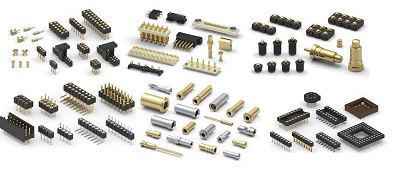Home > Mechanical Components > Mill-Max
Mill-Max – mechanical components

Mill-Max connectors are a popular brand of precision-machined electronic connectors and interconnect components. These connectors are widely used in various industries, including electronics, telecommunications, automotive, aerospace, and more. Mill-Max connectors are known for their high-quality construction, reliability, and versatility. Mill-Max is the leading US manufacturer of precision-machined interconnect components. With a vertically integrated engineering and manufacturing company capable of producing over 100 million interconnect components a week, Mill-Max is the largest manufacturer of precision machined interconnect components in North America.
 Mill-Max’s product line includes precision-machined spring-loaded connectors, SIP, DIP, PGA, BGA, and PLCC sockets, board-to-board interconnects and pin headers, PCB pins, receptacles and solder terminals, all available in SMT and through-hole. They also are the source for wrapost receptacles and terminals, PLCC sockets and USB connectors. In addition, they offer military sockets, stamped DIP sockets, low-cost PLCCs, and lubricated DIP and PLCC sockets.
Mill-Max’s product line includes precision-machined spring-loaded connectors, SIP, DIP, PGA, BGA, and PLCC sockets, board-to-board interconnects and pin headers, PCB pins, receptacles and solder terminals, all available in SMT and through-hole. They also are the source for wrapost receptacles and terminals, PLCC sockets and USB connectors. In addition, they offer military sockets, stamped DIP sockets, low-cost PLCCs, and lubricated DIP and PLCC sockets.
-
Mill-Max connectors are known for their precise and high-quality machining. They are typically manufactured using automated precision machining processes that ensure tight tolerances and consistent performance.
-
Variety of Connectors: Mill-Max offers a wide range of connectors, including board-to-board connectors, IC sockets, receptacles, headers, and spring-loaded connectors. These connectors serve different applications and requirements, from standard PCB connections to more specialized applications.
-
Spring-Loaded Connectors: Mill-Max is particularly well-known for its spring-loaded connectors, which are used in applications that require reliable and durable connections. These connectors use spring-loaded pins to make contact with other components or connectors, ensuring a secure electrical connection.
-
High-Quality Materials: Mill-Max connectors are typically constructed from high-quality materials, such as brass, phosphor bronze, and other suitable alloys. These materials provide excellent electrical conductivity and durability.
Connectors are fundamental components used in electronics to create and manage electrical connections between various devices, components, and circuits. These connectors serve as the interface points for the exchange of signals, power, and data within electronic systems. Here's an overview of connectors commonly used in electronics:
-
PCB Connectors:
- Header and Receptacle Connectors: These connectors are used on printed circuit boards (PCBs) and provide a way to connect the PCB to other boards or external devices.
- Edge Connectors: Edge connectors are used to interface with other PCBs or cards by plugging them into a receptacle or slot.
- Board-to-Board Connectors: These connectors enable connections between two separate PCBs.
-
Wire-to-Board Connectors:
- Crimp Connectors: Commonly used in cable assemblies, these connectors provide a reliable way to connect wires to PCBs.
- Wire-to-Board Header and Receptacle Connectors: These connectors connect wires to a PCB, enabling the transfer of power and signals.
-
Wire-to-Wire Connectors:
- Crimp Connectors: These are used to connect two or more wires together securely.
- Terminal Blocks: Terminal blocks offer a means to connect multiple wires or cables in an organized manner.
-
Circular Connectors:
- Used in harsh environments, these connectors are designed to be rugged and weather-resistant. They are common in military, aerospace, and industrial applications.
-
Coaxial Connectors:
- Coaxial connectors are used for RF (radio frequency) applications and video signals. They have a central conductor surrounded by an insulating layer and an outer shield.
-
D-Sub Connectors:
- D-Sub connectors are often used for serial data communication and video connections. They have a distinctive "D" shape with multiple pins or sockets.
-
Audio and Video Connectors:
- Connectors like RCA, HDMI, and XLR are used for audio and video signal transmission in consumer electronics and professional audio-visual equipment.
-
USB Connectors:
- USB connectors are widely used for connecting a variety of devices to computers and other electronic equipment. They come in different sizes, including USB-A, USB-B, and USB-C.
-
Power Connectors:
- Power connectors are designed to handle high current and voltage levels, making them suitable for power distribution in electronic systems.
-
Fiber Optic Connectors:
- Fiber optic connectors are used to connect optical fibers for high-speed data transmission in telecom, data center, and networking applications.
- Memory Card Connectors:
- These connectors are designed to interface with memory cards like SD cards and SIM cards used in mobile devices and digital cameras.
- Modular Connectors:
- Modular connectors are used in networking applications, particularly for telephone and Ethernet connections.
- Spring-Loaded Connectors:
- Spring-loaded connectors are used in applications that require temporary electrical connections, such as testing and programming.
Connectors play a crucial role in ensuring that electronic systems function as intended. They must be selected based on the specific requirements of a given application, including factors like the type of signals, power levels, environmental conditions, and size constraints. Proper connector selection and design are critical for reliable and efficient electronic systems.